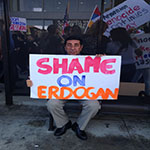Continued from page 1
The frequency and aggressive nature of the street harassment in the area was unlike anything she experienced before.
“It was almost like a culture shock,” she said. “I was like, ‘Why is this happening to me?’”
Jirapolchet, 20, works three jobs while attending school. She works in various roles, including marketing and production management, but many of her duties require working with contractors.
She has to travel to various parts of downtown and, before she got a car, she had to take public transportation everywhere.
More than once, she’s been followed from her bus stop a few blocks from her apartment in the South Park neighborhood.
“One time, I had to go into 7-Eleven because someone was following me around the block,” she said.
She waited inside the convenience store until her boyfriend was able to meet her and walk her home.
She still doesn’t feel secure traveling to the places she needs to because the lack of parking options downtown often means she has to walk many blocks to her destination.
“I feel uncomfortable sometimes,” she said. “I had to pick up a friend or my boyfriend to go with me [to work] a few times.”
Jirapolchet’s goal is to get a Master of Business Association from New York University and to eventually open her own apparel manufacturing company.
When the threat of street harassment is so pervasive, however, it gets hard trying to get from point A to point B.
And she’s not alone. Many women’s career goals, like Jirapolchet’s, are affected by street harassment.
Celeste Perez, 27, is a brand manager for Six Taste, a food tourism company, and has lived downtown for over eight years.
“I definitely do get unwanted attention when I’m walking,” said Perez, who often gives tours in various parts of downtown. “It’s part of my daily now.”
She’s had to make a conscious effort to think about what she’s going to wear depending on the area where she is going to give a tour.
She wore a light, summery dress on one of her tours, but “it was just too much of a hassle,” she said in reference to the cat-calls she got on the street.
“I just didn’t feel comfortable and I didn’t feel safe,” said Perez. “I felt like it was demeaning what I do. I’m standing there as a woman… as an authority figure telling people [where to eat]. Getting hit on like that doesn’t look good and it doesn’t feel good to me.”
The problem isn’t just something that affects grown women. It affects young girls too.
In fact, a new study by Heather Hlavka in the academic journal Gender & Society journal found that young girls view gender-based violence as normal.
“Many regard harassment and violence to be a normal part of everyday life in middle and high schools, yet most of these crimes go unreported,” Hlavka writes.
Hlavka’s study analyzed forensic interviews by the Children’s Advocacy Center with 100 children between the ages of three and 17 who were identified as possible sexual assault victims.
“Objectification, sexual harassment, and abuse appear to be part of the fabric of young women’s lives,” Hlavka wrote. “They had few available safe spaces; girls were harassed and assaulted at parties, in school, on the playground, on buses, and in cars.”
This type of violent behavior was seen as normal because boys and men were seen as natural sexual aggressors, according to the study.
A 13-year-old interviewee revealed in the study, “‘They grab you, touch your butt and try to, like, touch you in the front, and run away, but it’s okay, I mean… I never think it’s a big thing because they do it to everyone.’”
Hlavka goes on to describe that girls find “unwelcome touching and grabbing as normal, commonplace behaviors.”
The finding that girls consider this type of gender-based violence as just “boys being boys” serves as evidence to what many women’s advocates have claimed for years: that incidences of rape are vastly underreported.
In fact, 60% of sexual assaults are not reported to the police and 44% of victims are under the age of 18, according to the Rape, Abuse & Incest National Network.
For many women, the first time they were ever harassed on the street is something they never forget.
“I was 11, maybe 12, when it first happened,” said Renee Bracey Sherman, 28.
She was gardening with her parents outside their home in Chicago, when men started honking, yelling, blowing kisses and making “obscene gestures related to oral sex” as they drove by, she said.
“It was so sad that such a wonderful moment was ruined,” Sherman, a reproductive health writer and activist, said. “I ran in the house crying. My childhood had just been taken from me so quickly.”
She can’t recall a single day that she hasn’t been harassed on the street since then.
Jessica Roy was about 12 years old when she first got harassed.
“I had gotten roller blades for Christmas,” said Roy. “I was so jazzed.”
Like any kid obsessed with new wheels, she rode her roller blades around and around the block where she lived in Illinois.
One of those times, a jeep pulled over and a group of guys yelled “woooooo!” at her, according to Roy, 27.
“I was like, ‘ewwww,’” she recalled. “That was the first time that happened to me. I remember I stopped rollerblading after that.”
Street harassment hasn’t abated for Roy either.
“It’s an expected part of ‘walking while female,’” she said. “You’re going to get shouted at.”
Street harassment is also an international issue, affecting people not just in big cities like Los Angeles and New York.
This is why the organization Holla Back is a global organization, with chapters in over 75 cities and 26 countries around the globe, including Guyana, Croatia and Nepal.
The non-profit organization is dedicated to ending street harassment and emphasizes storytelling as a way to not only raise awareness, but ensure that victims feel less alone.
Holla Back organizers created a bystander intervention guide, an online mapping project, and even a real-time reporting iPhone and Android app.
Genevieve Berrick started the L.A. chapter after moving from Australia, not long after dealing with a traumatic case of street harassment on her doorstep.
She stepped outside her front door, fiddled with her keys for a moment, before looking up to realize a man was masturbating on her porch.
“I felt hugely violated,” she said. “[Events like that] could quite easily stop me from ever wanting to leave the house.”
Being such an active part of the movement to end street harassment is what gives her the motivation to leave her house, she said.
But it’s not just women who are fighting to change the culture of street harassment.
Abraham Adams is an editor in New York and started the Tumblr Men Taking Up Too Much Space On The Train about eight months ago.
Adams updates the site almost every day with photos people submit of men they’ve anonymously photographed on the train.
The site got so popular that Huffington Post, Buzzfeed, and TIME featured the blog on their sites last September.
Adams believes the issue of men taking up large amounts of space on the subway represents “a classic among public assertions of privilege,” which is one side of the spectrum that leads to street harassment.
“Men take up this amount of space because they conceive of not just their personal space as theirs, but the space around them as theirs,” said Adams. “Public space is conceived as masculine space that women come into.”
He’s hoping to make T-shirts one day with images from his site to spur conversations about the issue.
The connection between men taking up a lot of space and street harassment is undeniable for Renee Bracey Sherman, who said she experiences harassment every day, including “people coming really close to me and blowing kisses in my ear.”
“[Men are] making their presence known, letting you know that they see you and dominate you… like something to be objectified,” she said.
This demand for attention and pressure to respond has made Sherman learn how to walk fast. She also wears headphones, even when she’s not listening to anything, to make herself more unapproachable.
But just because she has safeguards against street harassment, doesn’t mean she never wants to be approached.
“If you actually think I’m pretty and want to have a conversation with me, get out of your car and ask me what book I’m reading,” said the writer and activist. “Ask me what I think about the economy. I’m more than just a pretty face.”



